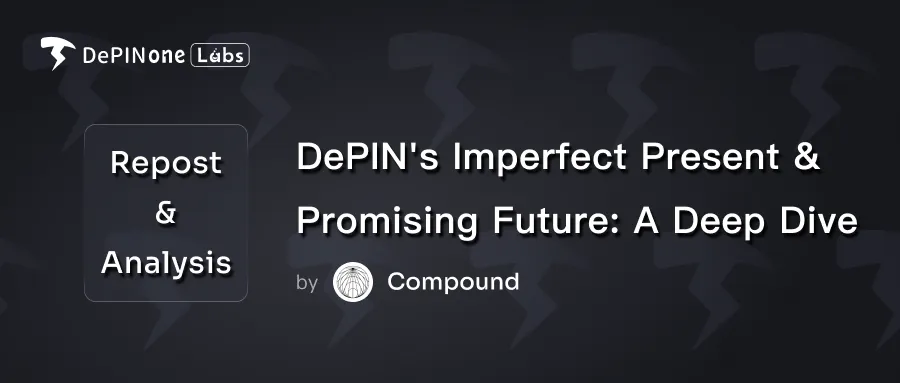
This article is from Compound, authored byKnowerandSmac
Published on: September 12, 2024
Original link:https://www.compound.vc/writing/depin
Approximately 50,000 words | Estimated reading time: 20 minutes
Editor’s Note
Why This Report Matters?
- DePIN(Decentralized Physical Infrastructure Networks) explores how decentralized technologies can construct and manage real-world physical infrastructure, potentially disrupting traditional industries. Understanding DePIN is critical to grasping the future trajectory of Web3.
- The report systematically categorizes DePIN intosix sub-sectors— telecom, energy, computing, decentralized AI, data, and services — mapping the entire ecosystem. Each sector includesreal operational datafrom leading projects (e.g., user growth, revenue models) to quantify market viability.
- Rather than hyping DePIN’s potential, the report objectively highlights its“imperfect realities”: sustainability challenges in tokenomics, competition with centralized incumbents, and uncertainties posed by emerging technologies (6G, photonic computing, distributed training). This balanced perspective enables rational evaluation.
To help readers grasp key insights efficiently, we’ve prepared an executive summary.
Key Content TL; DR
This report deeply explores the concept, current status, challenges, and future ofDePIN(Decentralized Physical Infrastructure Networks).
DePIN aims to reshape traditional physical infrastructure construction and management models through blockchain and decentralized incentives, achieving higher resource utilization, transparency, and resilient ownership. The article emphasizes that true disruption lies in solving the pain points of high-cost, low-efficiency centralized models, rather than simply pursuing “decentralization”.
The report divides the DePIN field intosix major sub-categories:
- Telecom & Connectivity: From DeWi to fixed wireless and public WiFi, with detailed analyses of projects like Helium, Karrier, Really, Andrena, Althea, Dabba, and WiCrypt regarding their technical approaches and market positioning.
- Energy: Distributed Energy Resources (DER), Virtual Power Plants (VPP), and on-chain financing platforms, covering business models and regulatory challenges of protocols like Daylight, SCRFUL, Plural Energy, Glow, StarPower, and Power Ledger.
- Compute, Storage & Bandwidth: Exploration of decentralized computing markets (Akash, Fluence, IONet, Hyperbolic, Render, Livepeer) and storage networks (Jackal, Arweave, Filecoin), comparing their performance and differences.
- Decentralized AI: Listing projects including Prime Intellect, Bittensor, Gensyn, Prodia, Ritual, and Grass, analyzing the integration prospects of decentralized training, verification, and data layers.
- Data Capture & Management: Emphasizing the market value and monetization challenges of content distribution, mapping, geolocation, and climate/weather data.
- Services: Showcasing innovative use cases like Dimo, PuffPaw, Heale, Silencio, Blackbird, and Shaga that leverage crypto incentives to drive real-world behaviors.
While DePIN demonstrates immense potential and is considered one of the most sustainable long-term investment directions in crypto, it remains in early-stage development, facing multiple “imperfect” real-world challenges such as token economic model dilemmas, genuine demand vs. adoption, supply-demand imbalances, competition, and regulation.
Despite these challenges, the report maintains an optimistic outlook (“bright future”) for DePIN, believing in its significant long-term potential.
Future development hinges on solving token economy sustainability issues, truly focusing on addressing meaningful real-world problems, and potentially finding breakthroughs in innovative fields like environmental monitoring, bio-data, and personal data sharing (e.g., bioacoustics, eDNA, sleep/dream data mentioned in the report), thereby charting the course for subsequent innovations.
For deeper insights into DePIN’s technical architectures and evolutionary pathways, explore the complete analysis 👇
